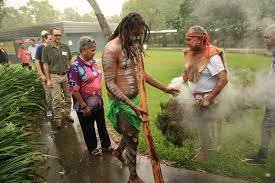Australia’s linguistic heritage is as ancient and diverse as the land itself, with Aboriginal languages forming a crucial part of the country’s cultural fabric. Before European settlement, over 250 languages spoken by Indigenous peoples flourished across the continent, each telling its own story and offering unique perspectives on the world. At Eddy Andrews Conceptual Copywriting, we recognize the profound significance of these languages—not only as means of communication but as vital expressions of culture, identity, and connection to Country. This blog post explores the importance of Aboriginal languages and the efforts to revitalize and preserve them for future generations.
The Rich Tapestry of Aboriginal Languages
Aboriginal languages are more than just systems of communication; they are deeply embedded in the culture, spirituality, and knowledge of Indigenous Australians. These languages carry within them millennia of oral histories, traditional ecological knowledge, and spiritual practices that are intrinsically linked to the land. Each language reflects the unique experiences, relationships, and environmental understanding of its speakers, offering insights into Australia’s natural and cultural heritage.
The Threat to Aboriginal Languages
The arrival of European settlers marked the beginning of a devastating impact on Indigenous communities and their languages. Policies of assimilation, displacement, and cultural suppression led to a dramatic decline in the use of Aboriginal languages. Today, many of these languages are considered endangered, with only around 120 being spoken regularly and many of those at risk of being lost forever.
The Importance of Language Revitalization
Revitalizing Aboriginal languages is crucial for several reasons. Firstly, it is a matter of cultural survival. Languages are carriers of culture; without them, vital aspects of Indigenous heritage and identity are at risk of being eroded. Secondly, language revitalization is linked to well-being. Research has shown that connection to cultural heritage, including language, can have positive impacts on health and well-being for Indigenous peoples. Finally, preserving Aboriginal languages enriches the entire nation, offering all Australians a deeper understanding of the country’s history and cultural diversity.
Efforts in Revitalization and Preservation
Across Australia, Indigenous communities, linguists, and educators are working tirelessly to revitalize and preserve Aboriginal languages. This work includes language documentation, the development of educational resources, and the incorporation of Indigenous languages into school curriculums. Technology is playing a significant role, with apps and online platforms being developed to make learning languages more accessible. Additionally, the inclusion of Aboriginal languages in public signs, broadcasts, and national events is helping to raise awareness and respect for these languages.
How You Can Support Aboriginal Languages
Supporting the revitalization of Aboriginal languages is something everyone can be part of. Educating yourself about the local Indigenous languages of your area, acknowledging traditional language owners in meetings and events, and supporting Indigenous-led language initiatives are all ways to contribute. Additionally, advocating for policies and funding that support language preservation efforts is crucial for the long-term survival of these languages.
Conclusion
Aboriginal languages are an irreplaceable treasure, offering insights into Australia’s rich Indigenous cultures and the profound connection between people and the land. The efforts to revitalize and preserve these languages are not just about saving words; they are about honoring and sustaining the cultural heritage of Australia’s First Peoples. At Eddy Andrews Conceptual Copywriting, we stand in awe of the resilience and beauty of Aboriginal languages and support the endeavors to keep these voices of the land alive for generations to come.

